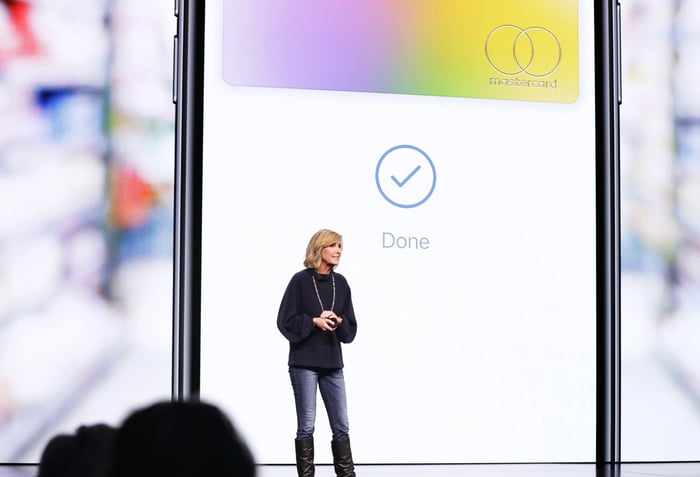There are a lot of things to like about Apple's (AAPL -1.22%) foray into credit cards, the Apple Card. Unveiled yesterday and launching this summer, Apple Card does away with many of the pesky fees and penalties that nickel and dime consumers, offers an intuitive interface for managing spending and paying bills, and includes numerous features that offer improved privacy and security. Apple has partnered with Goldman Sachs (GS 0.22%) to offer the card, as the investment banking firm has been expanding into consumer lending in recent years.
It also offers a straightforward reward system that credits cash back on a daily basis. However, the rewards that most users end up realizing will likely be underwhelming compared to what the competition offers.

Apple Pay chief Jennifer Bailey unveils Apple Card. Image source: Apple.
Goldman underwhelmed by Goldman
Apple Card offers three different tiers of cash-back rewards: 3% back on Apple purchases, 2% back on Apple Pay contactless purchases, and 1% back on physical card purchases. The average cash-back rate will depend on the user's mix of these categories.
Goldman Sachs analysts released a research note (via CNBC) estimating that the card will end up giving back closer to 1% for most users. "Even though Apple Pay is becoming more available, we would still expect a large percentage of transactions to be done at the 1% return level (using the physical card) so we would expect the typical consumer to perceive the cash return rate to be OK but not great," analysts led by Rod Hall wrote in the note.
At the event, CEO Tim Cook noted that merchant acceptance of Apple Pay in the U.S. has hit 70%. Merchant acceptance is higher in other parts of the world, but Apple Card is initially launching only in the U.S.

Apple Pay merchant acceptance has hit 70% in the U.S. Image source: Apple.
Separately, Loup Ventures estimated last month that there are around 46 million Apple Pay users in the U.S. as adoption continues to climb. However, those are merely users that have activated Apple Pay, and the estimates say nothing about actual usage or purchase behavior. Changing consumer behavior at the register is a different question altogether, as contactless payments only offer slightly more convenience than physical card payments.
It's also worth noting that an average Apple customer's most frequent large purchase is likely to be an iPhone, as average upgrade cycles for iPads and Macs tend to be much longer in general. But the majority of U.S. iPhones are purchased through carriers and then billed monthly through installment plans. Those purchases wouldn't qualify for the 3% reward rate, which only applies to purchases made directly through Apple (including services). That highest tier would only apply to a tiny proportion of an average customer's annual household spending, assuming you're not buying an iPad every week.
Check out the latest earnings call transcript for Apple.
Old payment habits die hard
If the average consumer can expect to get close to 1% cash back on average, the Apple Card won't be competitive with other comparable cards that offer 1.5% cash back with no annual fee. Apple doesn't seem to be interested in competing in the highly competitive premium credit card space, where financial heavyweights like JPMorgan Chase and American Express dominate with offerings like the Sapphire Reserve and Platinum Card, respectively.

Apple is incentivizing contactless payments. Image source: Apple.
A few years back, it was reported that Apple collects an estimated 15 basis points of payment volumes processed with Apple Pay. The company is able to earn that unprecedented cut by offering increased security and authentication. Apple Pay uses tokenization that strengthens security, and Apple's Face ID and Touch ID biometric authentication technologies are much stronger than signing on the dotted line. Apple Pay contactless transactions are considered "card present transactions," a category that carries less risk for merchants and card issuers and comes with lower processing fees for the merchant.
A Wall Street Journal report from last year suggested that Apple could double its take to around 30 basis points for the new Apple Card. That could explain why Apple Pay contactless payments earn higher rewards, since the tech titan has stronger monetization of those transactions. The reward structure is clearly trying to incentivize more Apple Pay contactless payments, which in turn could help grow the services business to the extent that Apple is successful in getting consumers to change their payment ways.





